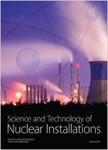版权所有:内蒙古大学图书馆 技术提供:维普资讯• 智图
内蒙古自治区呼和浩特市赛罕区大学西街235号 邮编: 010021

作者机构:North China Elect Power Univ Beijing Key Lab Pass Nucl Safety Technol Beijing 102206 Peoples R China
出 版 物:《SCIENCE AND TECHNOLOGY OF NUCLEAR INSTALLATIONS》 (核装置科学和技术)
年 卷 期:2015年第2015卷第2-18期
页 面:8-8页
核心收录:
学科分类:07[理学] 0827[工学-核科学与技术] 070202[理学-粒子物理与原子核物理] 0702[理学-物理学]
主 题:FLUID-structure interaction DYNAMIC models SEISMOLOGY COOLING systems WATER storage STRESS concentration
摘 要:Huge water storage tank on the top of many buildings may affect the safety of the structure caused by fluid-structure interaction (FSI) under the earthquake. AP1000 passive containment cooling system water storage tank (PCCWST) placed at the top of shield building is a key component to ensure the safety of nuclear facilities. Under seismic loading, water will impact the wall of PCCWST, which may pose a threat to the integrity of the shield building. In the present study, an FE model of AP1000 shield building is built for the modal and transient seismic analysis considering the FSI. Six different water levels in PCCWST were discussed by comparing the modal frequency, seismic acceleration response, and von Mises stress distribution. The results show the maximum von Mises stress emerges at the joint of shield building roof and water around the air inlet. However, the maximum von Mises stress is below the yield strength of reinforced concrete. The results may provide a reference for design of the AP1000 and CAP1400 in the future.